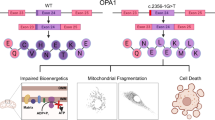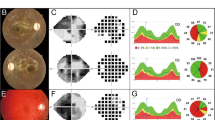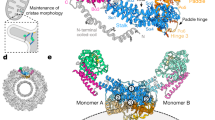Abstract
Optic atrophy type 1 (OPA1, MIM 165500) is a dominantly inherited optic neuropathy occurring in 1 in 50,000 individuals1,2,3 that features progressive loss in visual acuity leading, in many cases, to legal blindness4,5,6,7,8. Phenotypic variations5 and loss of retinal ganglion cells9,10, as found in Leber hereditary optic neuropathy (LHON), have suggested possible mitochondrial impairment11,12. The OPA1 gene has been localized to 3q28–q29 (refs 13–19). We describe here a nuclear gene, OPA1, that maps within the candidate region and encodes a dynamin-related protein localized to mitochondria. We found four different OPA1 mutations, including frameshift and missense mutations, to segregate with the disease, demonstrating a role for mitochondria in retinal ganglion cell pathophysiology.
This is a preview of subscription content, access via your institution
Access options
Subscribe to this journal
Receive 12 print issues and online access
$209.00 per year
only $17.42 per issue
Buy this article
- Purchase on Springer Link
- Instant access to full article PDF
Prices may be subject to local taxes which are calculated during checkout





Similar content being viewed by others
References
Kjer, P. Infantile optic atrophy with dominant mode of inheritance: a clinical and genetic study of 19 Danish families. Acta Ophthalmol. Scand. 37 (suppl. 54), 1–146 (1959).
Kjer, B., Eiberg, H., Kjer, P. & Rosenberg, T. Dominant optic atrophy mapped to chromosome 3q region. II. Clinical and epidemiological aspects. Acta Ophthalmol. Scand. 74, 3–7 (1996).
Eliott, D., Traboulsi, E.I. & Maumenee, I.H. Visual prognosis in autosomal dominant optic atrophy (Kjer type). Am. J. Ophthalmol. 115, 360–367 (1993).
Smith, D.P. Diagnostic criteria in dominantly inherited juvenile optic atrophy: a report of three new families. Am. J. Optom. Arch. Am. Acad. Optom. 49, 183–200 (1972).
Hoyt, C.S. Autosomal dominant optic atrophy: a spectrum of disability. Ophthalmology 87, 245–251 (1980).
Jaeger, W. Diagnosis of dominant infantile optic atrophy in early childhood. Ophthalmic. Paediatr. Genet. 9, 7–11 (1988).
Votruba, M., Moore, A.T. & Bhattacharya, S.S. Clinical features, molecular genetics, and pathophysiology of dominant optic atrophy. J. Med. Genet. 35, 793–800 (1998).
Johnston, R.L., Seller, M.J., Behnam, J.T., Burdon, M.A. & Spalton, D.J. Dominant optic atrophy: refining the clinical diagnostic criteria in light of genetic linkage studies. Ophthalmology 106, 123–128 (1999).
Johnston, P.B., Gaster, R.N., Smith, V.C. & Tripathi, R.C. A clinicopathological study of autosomal dominant optic atrophy. Am. J. Ophthalmol. 88, 668–675 (1979).
Kjer, P., Jensen, O.A. & Klinken, L. Histopathology of eye, optic nerve and brain in a case of dominant optic atrophy. Acta Ophthalmol. 61, 300–312 (1983).
Kerrison, J.B., Howell, N., Miller, N.R., Hirst, L. & Green, W.R. Leber hereditary optic neuropathy. Electron microscopy and molecular genetic analysis of a case. Ophthalmology 102, 1509–1516 (1995).
Howell, N. Leber hereditary optic neuropathy: how do mitochondrial DNA mutations cause degeneration of the optic nerve? J. Bioenerg. Biomembr. 29, 165–173 (1997).
Eiberg, H., Kjer, B., Kjer, P. & Rosenberg, T. Dominant optic atrophy (OPA1) mapped to chromosome 3q region. 1. Linkage analysis. Hum. Mol. Genet. 3, 977–980 (1994).
Lunkes, A. et al. Refinement of the OPA1 gene locus on chromosome 3q28–q29 to a region of 2–8 cM, in one Cuban pedigree with autosomal dominant optic atrophy type Kjer. Am. J. Hum. Genet. 57, 968–970 (1995).
Bonneau, D. et al. No evidence of genetic heterogeneity in dominant optic atrophy. J. Med. Genet. 32, 951–953 (1995).
Votruba, M., Moore, A.T. & Bhattacharya, S.S. Genetic refinement of dominant optic atrophy (OPA1) locus to within a 2 cM interval of chromosome 3q. J. Med. Genet. 34, 117–121 (1997).
Brown, J. et al. Clinical and genetic analysis of a family affected with dominant optic atrophy (OPA1). Arch. Ophthalmol. 115, 95–99 (1997).
Johnston, R.L. et al. Dominant optic atrophy, Kjer type. Linkage analysis and clinical features in a large British pedigree. Arch. Ophthalmol. 115, 100–103 (1997).
Votruba, M., Moore, A.T. & Bhattacharya, S.S. Demonstration of a founder effect and fine mapping of dominant optic atrophy locus on 3q28-qter by linkage disequilibrium method. A study of 38 British Isles pedigrees. Hum. Genet. 102, 79–86 (1998).
Pelloquin, L., Belenguer, P., Menon, Y. & Ducommun, B. Identification of a fission yeast dynamin-related protein involved in mitochondrial DNA maintenance. Biochem. Biophys. Res. Commun. 251, 720–726 (1998).
Pelloquin, L., Belenguer, P., Gas, N., Menon, Y. & Ducommun, B. Fission yeast Msp1 is a mitochondrial dynamin related protein. J. Cell Sci. 112, 4151–4161 (1999).
Jones, B. & Fangman, W. Mitochondrial DNA maintenance in yeast requires a protein containing a region related to the GTP-binding domain of dynamin. Genes Dev. 6, 380–389 (1992).
van der Bliek, A.M. Functional diversity in the dynamin family. Trends Cell Biol. 9, 96–102 (1999).
Nagase, T. et al. Prediction of the coding sequences of unidentified human genes. IX. The complete sequences of 100 new cDNA clones from brain which can code for large proteins in vitro. DNA Res. 5, 31–39 (1998).
Smirnova, E., Shurland, D.L., Ryazantsev, S.N. & van der Bliek, A.M. A human dynamin-related protein controls the distribution of mitochondria. J. Cell Biol. 143, 351–358 (1998).
Kivlin, J.D., Lovrien, E.W., Bishop, D.T. & Maumenee, I.H. Linkage analysis in dominant optic atrophy. Am. J. Hum. Genet. 35, 1190–1195 (1983).
Seller, M.J. et al. Linkage studies in dominant optic atrophy, Kjer type: possible evidence for heterogeneity. J. Med. Genet. 34, 967–972 (1997).
Kerrison, J.B. et al. Genetic heterogeneity of dominant optic atrophy, Kjer type: identification of a second locus on chromosome 18q12.2–12.3. Arch. Ophthalmol. 117, 805–810 (1999).
Miller, S.A., Dykes, D.D. & Polesky, H.F. A simple salting out procedure for extracting DNA from human nucleated cells. Nucleic Acids Res. 16, 1215 (1988).
Le Cabec, V. & Maridonneau-Parini, I. Annexin 3 is associated with cytoplasmic granules in neutrophils and monocytes and translocates to the plasma membrane in activated cells. Biochem. J. 303, 481–487 (1994).
Acknowledgements
We thank the patients and their families for support; M. Roux, A. Dumas and J. Aimé for encouragement; P. Roustan for help; T. Nagase for providing clone HH2110 (human OPA1 cDNA); and P. Gaudray for help in gene localization. This work was supported by Association Française contre les Myopathies, CHU de Montpellier, Fondation pour la Recherche Médicale, Information Recherche sur les Rétinites Pigmentaires, Retina France and SOS Rétinite, France (C.D. is a recipient of a SOS Rétinite fellowship).
Author information
Authors and Affiliations
Corresponding authors
Rights and permissions
About this article
Cite this article
Delettre, C., Lenaers, G., Griffoin, JM. et al. Nuclear gene OPA1, encoding a mitochondrial dynamin-related protein, is mutated in dominant optic atrophy. Nat Genet 26, 207–210 (2000). https://doi.org/10.1038/79936
Received:
Accepted:
Issue Date:
DOI: https://doi.org/10.1038/79936
This article is cited by
-
Utility of ganglion cells for the evaluation of anterior visual pathway pathology: a review
Acta Neurologica Belgica (2024)
-
The human OPA1delTTAG mutation induces adult onset and progressive auditory neuropathy in mice
Cellular and Molecular Life Sciences (2024)
-
The mitochondrial Ahi1/GR participates the regulation on mtDNA copy numbers and brain ATP levels and modulates depressive behaviors in mice
Cell Communication and Signaling (2023)
-
MOF-mediated histone H4 Lysine 16 acetylation governs mitochondrial and ciliary functions by controlling gene promoters
Nature Communications (2023)
-
Structural mechanism of mitochondrial membrane remodelling by human OPA1
Nature (2023)



